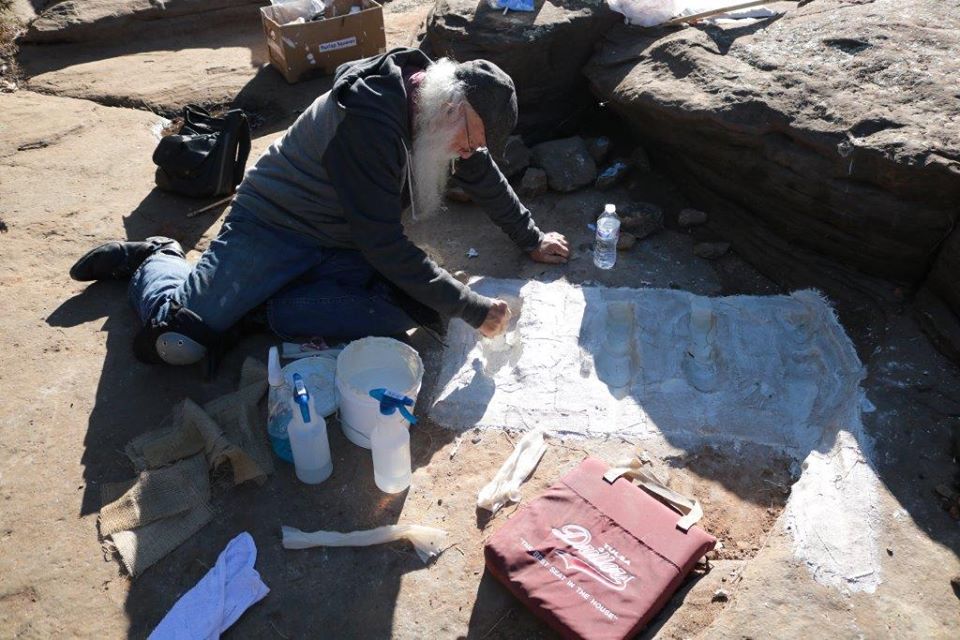April 20th, 2018
Explorers Find Human Artifact Impressions in Stone. Evidence of Prehistoric Plumbing?
By Todd Jurasek

In September 2015, Mike Sulivant and I were out hiking and looking for rock inscriptions. We took a random break from hiking and accidentally discovered something that we had been searching elsewhere for years for. The thing that we accidentally discovered is something that’s been described to us by a now deceased friend. We were not looking for this at that time.
In a sandstone creek bottom were four large jar-shaped impressions. Due to their shape, the friend had believed these to be possible mold halves of Egyptian funerary jars left by Pre-Columbian travelers thousands of years ago. These are known as “canopic jars”.
This seemed plausible until the water was removed revealing what appeared to be “ooparts” (Out Of Place Artifacts).
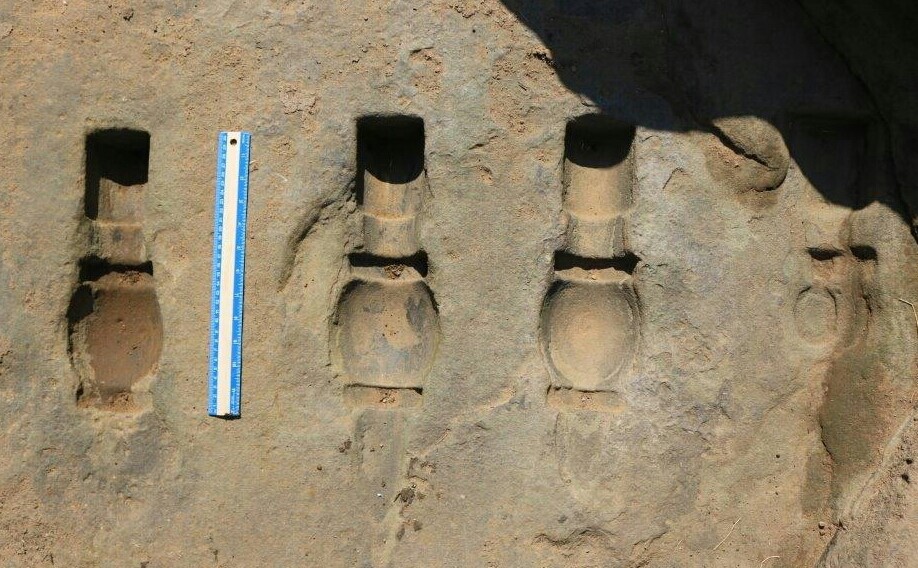
Fifth Object Found
I revisited the site again a few days after Mike and I stumbled upon our discovery. I found an additional fifth impression reported by our friend. I was able to locate this fifth impression upon remembering conversations Mike and I had had with our friend. This impression lay under multiple feet of water approximately 23 feet to the east of the original four. Once we found the original four, we knew we would have to at least partially drain the creek.
When I take photographs in the field, I always like to include familiar objects in the shots to give people a tangible sense of size and scale. I feel that this is very important in presentation as I document things that have never been seen before. This leaves a permanent image in the minds of people and enables them to connect with my experience.
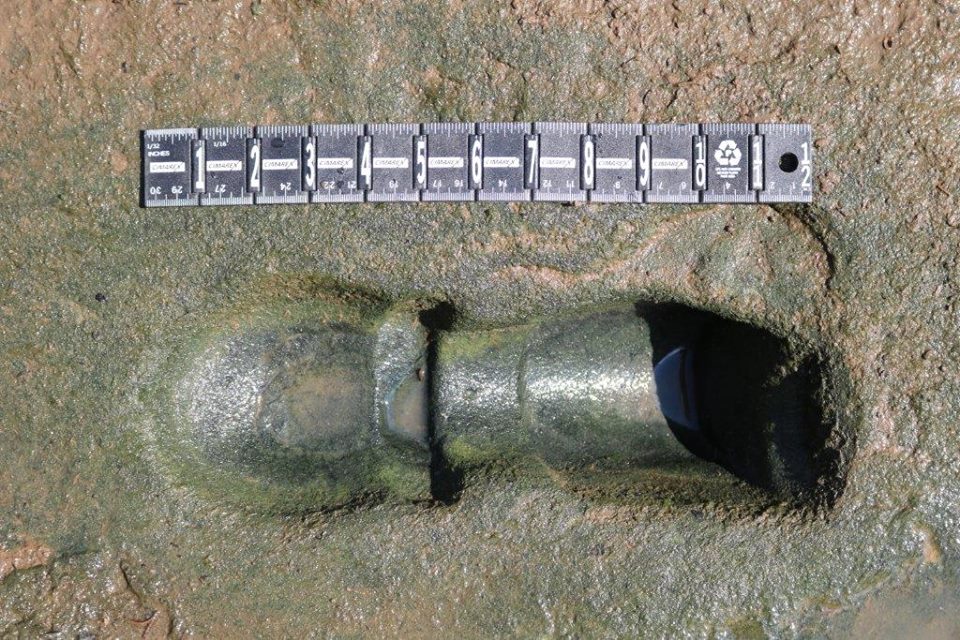
We were shocked. We had drained this creek thinking we would find some possible type of canopic jar or storage jars halves of pre Columbian travelers. It is well documented that ancient explorers from various cultures ventured into America using rivers as highways in search of adventure, trade, provisions, conquest, and new lands. What we found however, did not fit that narrative at all.
This was something entirely different. This was something quite odd. This was obviously something out of place. The popular expression “ooparts” has been used for last fifty years or so to describe artifacts that exist with no logical context. Ivan T. Sanderson, an American Zoologist with a passion for unknown and unexplained phenomena, dubbed the term “oopart”. An oopart is essentially an archeological or palaeontological object discovered in an unusual or impossible location. Examples of ooparts have been found across the globe over the centuries from the iron hammer encased in stone found in London, TX in 1934, to the aluminum wedge found buried thirty three feet under ground in Aiud, Romania in 1974.
Here are some additional examples of ooparts:
- The Meister track, a human sandal print found in Antelope Springs, UT in 1968 with two trilobites smashed on it.
- The Dorchester bell or vase blown out of rock by construction workers in Dorchester, MA in 1852.
- A cast iron pot found in a clump of coal in Thomas, OK in 1912.
- Two chariot wheels discovered embedded in Russian coal mine in 2008.
In September and October of 2017, Mike and I repeatedly drained the creek which took a lot of time and effort due to rain and underground water sources. Mike molded the five impressions in silicone revealing hexagonal features in the molds.
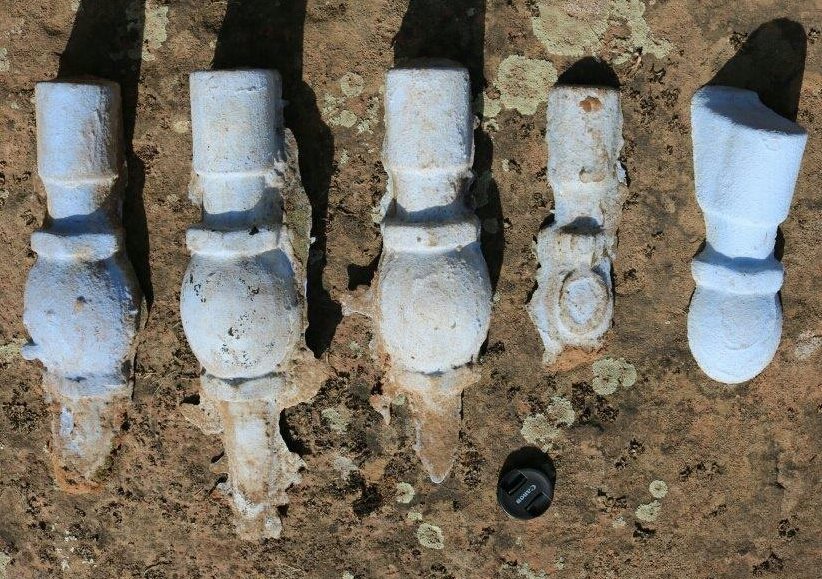
We knew that we needed quality 3-dimensional casts made of all these findings to be documented to see and study. I consulted a professional fossil restorer whom I have known for years about the find. He offered to come cast them for us.
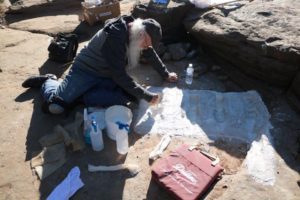
World renown fossil restorer Joe Taylor came in from Texas to mold the impressions. He molded the first four impressions and another impression located slightly above and directly to the north of the four that appeared to be related. Joe was unable to mold the fifth one (the one twenty three feet away) due to continual water seepage into the impression which made it impossible to mold that day. Both his and Mike’s casts offered tantalizing clues as to the design and origin of the objects.
Upon first seeing these things I had thought they they were possibly jar mold halves (used when producing jars), but once we pulled the molds out, I started to think these looked more like some type of plumbing equipment. Joe Taylor confirmed this by bringing plumbers to come check out his latex castings of the four main impressions.
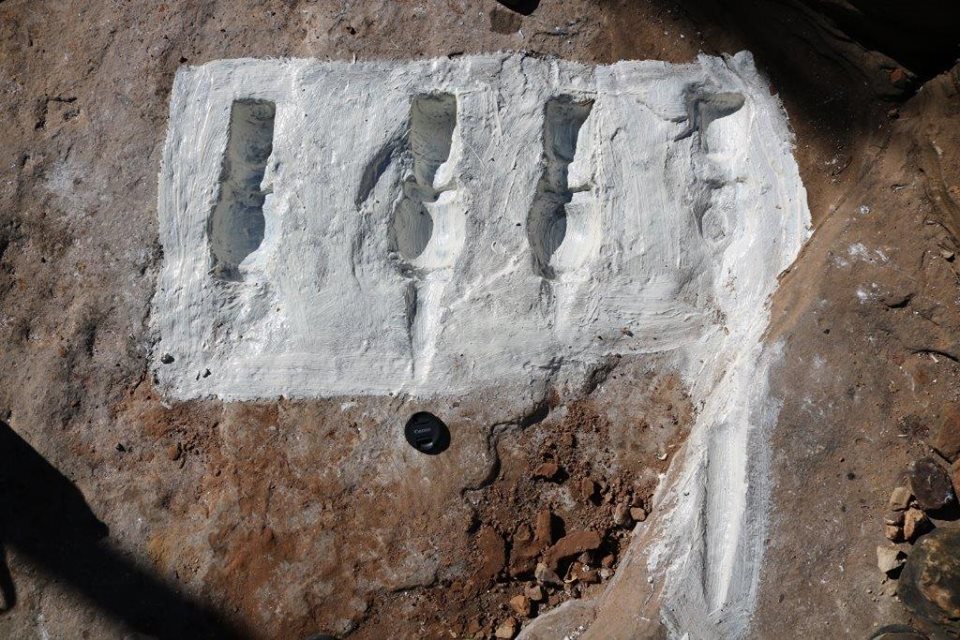
Heavily-Worn Sixth Impression Found
In early November 2017, I went back to the site to search for anything we may have overlooked. I discovered a heavily worn, barely visible, sixth impression of an object covered in a film of mud on the far eastern end of the creek bottom. This sixth impression was located approximately 12 feet to the east of the fifth impression.
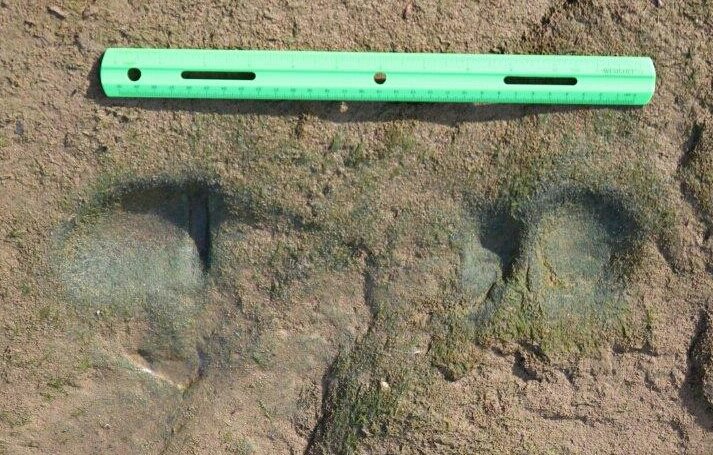
How old are these man-made metallic objects?
The impressions are those left by man-made metallic objects, possibly some form of prehistoric plumbing as postulated by Joe Taylor. The four main impressions have obvious metallic stain highly visible under certain lighting conditions.
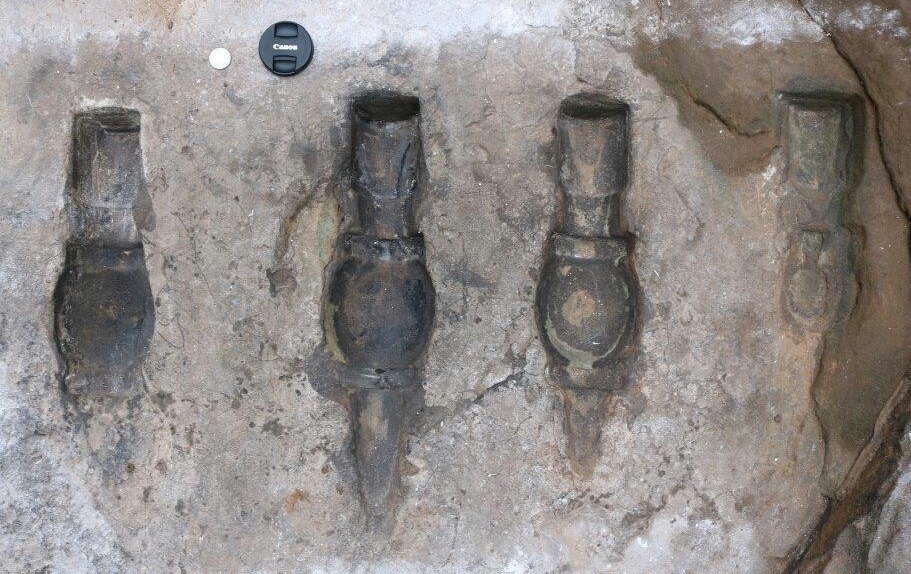
Noticeable in the above photo is obvious damage to the rock surrounding the items. Joe Taylor pointed out that the damage to the impressions appear to be the result of when the objects were pried out of the rock at some point in the past. This is particularly noticeable to the left of the second object.
Approximate Locations of the Impressions
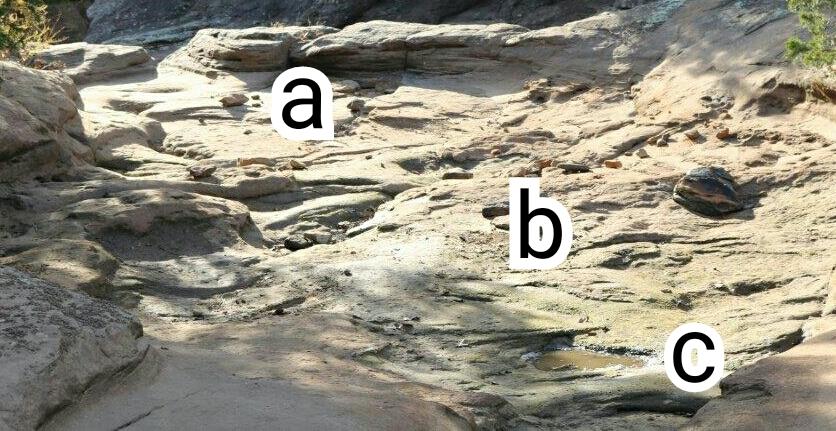
- (A) The four main impressions and a possible partial one.
- (B) Approximately 23 feet away is the fifth impression.
- (C) Approximately 12 feet away from the fifth is the sixth impression.
All six of the impressions are located at a depth of a little over 27 feet down below the normal surface terrain of this region. They are within a layer of sandstone and appear to be, in evolutionary terms, of “Pennsylvanian Age”, which is estimated to be from 286-320 million years old.
They are likely not carved, as even a skilled artisan would struggle carving hexagonal angles into the extremely hard bedrock. There are also obvious dark residual stains consistent with those left from metal objects. This was particularly noticeable in the main four impressions. In addition to this, the last of the main four and most heavily worn of the set is almost under the surrounding rock. It makes little sense to carve an impression this close to the edge when there is plenty of room . The fifth major impression is heavily distorted giving the appearance of an object that has been flash frozen in sediment after shifting somewhat. There is no way this one was carved.
The fact that all six impressions lay under a permanent water source eliminates the possibility that they were carved. It makes zero sense to dry out a creek bed and carve out the bottom only to risk having it fill up again in the future when suitable higher ground is available nearby. By far, the biggest problem with the impressions is that they appear to have been laid down at the same time as the surrounding rock strata, making them possibly hundreds of millions of years old on the evolutionary time table.
This is millions of years before the earliest humans supposedly came on the scene. But could the objects that caused these impressions actually be much younger?
The Holy Bible describes a worldwide flood that engulfed the earth destroying all flesh (Genesis chapter 6 thru chapter 9). This happened approximately 2,300 BC. Most civilizations of the world have references to a worldwide flood in their respective histories. During the time before this worldwide flood a relatively advanced human population with knowledge of metallurgy lived upon the earth (Genesis 4:22).
The worldwide Flood mentioned in the Holy Bible offers a solid overall explanation to the mystery of ooparts. According to the biblical account it rained for 40 days and 40 nights, and the earth was completely flooded for over a year. The Holy Bible further describes that at the time a water canopy, or “firmament”, existed in the heavens above the earth, which collapsed, playing a role in the devastation. On that same day fountains from water sources deep within the earth erupted, ripping apart the earth’s surface. The resulting damage from such an event would have been catastrophic, with the earth turning into a massive blender. Objects like those that left the impressions in this creek bed would have been scattered throughout earth’s geological layers.
Some people believe that ooparts are hoaxes. Others believe they are misidentifications. And still others believe they are the work of aliens or that they are the remains of intelligent life inhabiting the earth millions of years ago.
The impressions are an amazing find and proof we have so much to learn about the world we live in. Research on these ooparts is ongoing. We will continue to dig deeper into this mystery and will have more details in the months and years ahead.
The search continues…
Todd Jurasek
Check out my original article on my Facebook fanpage
April 20th, 2018

